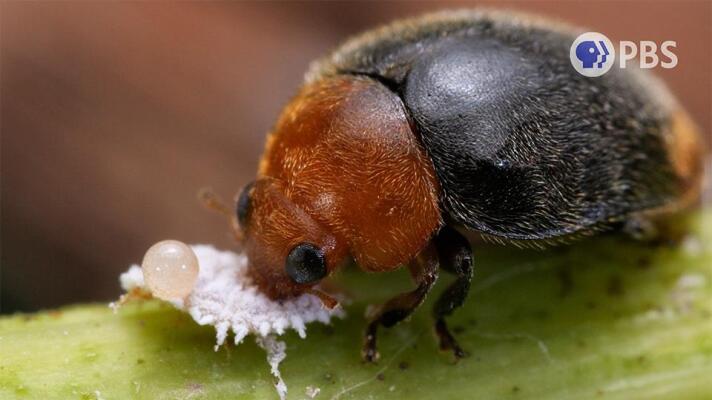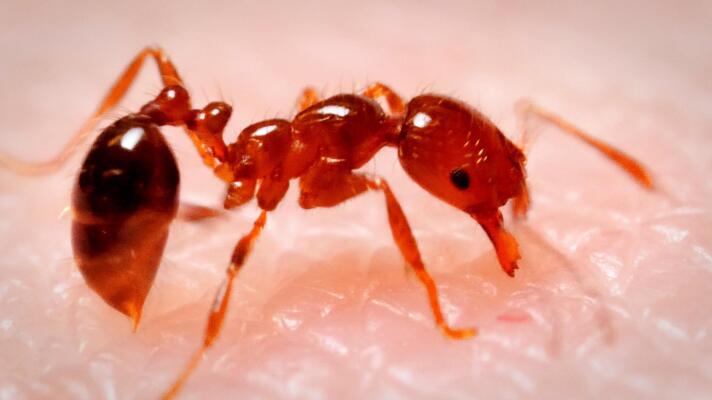Latest Episodes
All
-
All
-
Deep Look Season 12
-
Deep Look Season 11
-
Deep Look Season 10
-
Season 9
-
Deep Look Season 8
-
Deep Look Season 7
-
Deep Look Season 6
-
Deep Look Season 5
-
Deep Look Season 4
-
Deep Look Season 3
-
Deep Look Season 2
-
Deep Look Season 1
Peppermint stick insect packs a peppermint-scented blast powerful enough to fend off hungry predator
Episode:
S12
E16
|
4:46
If there ever was a bug that we should all raise a glass of wine for, it's the mealybug destroyer.
Episode:
S12
E12
|
3:57
Dragonflies and damselflies may look alike, but these expert hunters have distinct strategies.
Episode:
S12
E11
|
4:30
Tiger beetles sprint so quickly they momentarily outrun their own vision!
Episode:
S12
E10
|
3:28
Lovebugs can spend anywhere from a half-hour to a couple of days attached to each other.
Episode:
S12
E9
|
3:50
Do you really know who you’re sharing the beach with?
Episode:
S12
E8
|
20:06
Fire ants, kidnapper ants, honeypot ants and Argentine ants are ruthless!
Episode:
S12
E7
|
17:48
Tiny parasitoid wasps might help you say bye-bye to those smelly mothballs.
Episode:
S12
E6
|
4:42
The mosquito buzzing that you find annoying and disgusting is irresistible to a male mosquito.
Episode:
S12
E5
|
4:36
A male long-jawed orb weaver spider uses his huge jaws to avoid getting eaten while mating.
Episode:
S12
E4
|
4:12
Regal jumping spiders are masterful hunters with their athletic leaps, sharp fangs and lethal venom.
Episode:
S12
E3
|
4:47
We hope your spring cleaning doesn’t uncover these house pests!
Episode:
S11
E20
|
17:44
A rice weevil is a stowaway that sneaks into your pantry and turns your rice into its new home.
Episode:
S12
E2
|
3:28
Praying mantises, barnacles, newts and earthworms have some of the strangest love lives.
Episode:
S11
E19
|
15:06
Watch these hunters use stealth, speed and lethal weapons to dispatch their prey.
Episode:
S11
E18
|
14:54
After growing up inside a “grass taco,” a grass skipper butterfly emerges and woos a mate.
Episode:
S12
E1
|
4:54
Excirolana chiltoni hang out in the wet sand at the beach and might nibble at your feet!
Episode:
S11
E17
|
3:49
Green lacewings vibrate their bodies and sing to each other!
Episode:
S11
E16
|
3:49
These five types of bees collect food and make their nests in surprising ways.
Episode:
S11
E15
|
23:22
These plants spend their whole life getting in just the right position.
Episode:
S11
E14
|
5:00
Mosquitoes, ticks, lice, kissing bugs and tsetse flies are all looking to grab a bite ... of you.
Episode:
S11
E13
|
19:31
Burying beetles haul mouse carcasses into the dirt and prep them to start a family.
Episode:
S11
E12
|
4:32
Wandering salamanders can skydive in the branches of the tallest trees in the world.
Episode:
S11
E11
|
3:47
The petroleum fly and their larvae thrive in the natural asphalt at the La Brea Tar Pits.
Episode:
S11
E10
|
4:45
Six-rayed sea stars make great moms, caressing and protecting their babies for months!
Episode:
S11
E9
|
5:15
House flies deploy a specialized organ called the ptilinum to break out of their pupa!
Episode:
S11
E8
|
4:12
Stingless bees don’t have stingers. So, how do they keep honey thieves away?
Episode:
S11
E7
|
6:15
After cochineals die, their legacy lives on in the brilliant red hue produced by their hemolymph!
Episode:
S11
E6
|
5:16
Those rows of orange cluster under a fern leaf are spores waiting to be catapulted away.
Episode:
S11
E5
|
3:44
These tiny marine flatworms are smaller than a grain of rice but have amazing abilities!
Episode:
S11
E4
|
5:16
Sharpshooters have super-propulsive urine using a catapult in their butt.
Episode:
S11
E3
|
3:57
Corals create an underwater "snowstorm" by sending tiny white spheres up the water column.
Episode:
S11
E2
|
4:36
Ever wonder how those tiny, jumpy flies got onto your bathroom wall?
Episode:
S11
E1
|
3:58
Jellyfish clone themselves by morphing into a stack of squirming jellyfish pancakes.
Episode:
S10
E17
|
4:38
As temperatures rise, the brown dog tick is more likely to feast on you.
Episode:
S10
E16
|
4:28
This fuzzy acorn weevil uses her snout to drill through an acorn's shell.
Episode:
S10
E15
|
5:46
Beekeepers and scientists are helping honeybees fight off varroa mites.
Episode:
S10
E14
|
6:41
Ladybugs may be the cutest insects around, but they don't start off that way.
Episode:
S10
E13
|
5:14
Do cockroaches -- daring, disgusting disease vectors -- have anything at all to offer us?
Episode:
S10
E12
|
3:57
Covered in a shiny bubble, the alkali fly scuba dives in California's Mono Lake.
Episode:
S10
E11
|
5:42










































